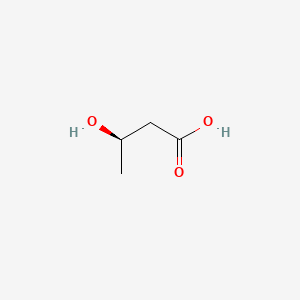| MeSH term | MeSH ID | Detail |
|---|---|---|
| Lipidoses | D008064 | 7 associated lipids |
| Hypopituitarism | D007018 | 7 associated lipids |
| Carcinoma, Non-Small-Cell Lung | D002289 | 72 associated lipids |
| Metabolic Syndrome | D024821 | 44 associated lipids |
| Amyotrophic Lateral Sclerosis | D000690 | 11 associated lipids |
| Diabetes, Gestational | D016640 | 8 associated lipids |
| Malnutrition | D044342 | 6 associated lipids |
| Insulin Resistance | D007333 | 99 associated lipids |
| Dehydration | D003681 | 11 associated lipids |
| Fatigue | D005221 | 10 associated lipids |
(r)-3-hydroxybutanoic acid
(r)-3-hydroxybutanoic acid is a lipid of Fatty Acyls (FA) class.
Cross Reference
There are no associated biomedical information in the current reference collection.
Current reference collection contains 2725 references associated with (r)-3-hydroxybutanoic acid in LipidPedia. Due to lack of full text of references or no associated biomedical terms are recognized in our current text-mining method, we cannot extract any biomedical terms related to diseases, pathways, locations, functions, genes, lipids, and animal models from the associated reference collection.
Users can download the reference list at the bottom of this page and read the reference manually to find out biomedical information.
Here are additional resources we collected from PubChem and MeSH for (r)-3-hydroxybutanoic acid
Possible diseases from mapped MeSH terms on references
We collected disease MeSH terms mapped to the references associated with (r)-3-hydroxybutanoic acid
PubChem Associated disorders and diseases
PubChem Biomolecular Interactions and Pathways
NCBI Entrez Crosslinks
All references with (r)-3-hydroxybutanoic acid
Download all related citations| Authors | Title | Published | Journal | PubMed Link |
|---|---|---|---|---|
| Pelletier A and Coderre L | Ketone bodies alter dinitrophenol-induced glucose uptake through AMPK inhibition and oxidative stress generation in adult cardiomyocytes. | 2007 | Am. J. Physiol. Endocrinol. Metab. | pmid:17227964 |
| Chu CA et al. | Effects of free fatty acids on hepatic glycogenolysis and gluconeogenesis in conscious dogs. | 2002 | Am. J. Physiol. Endocrinol. Metab. | pmid:11788373 |
| McGregor VP et al. | Elevated endogenous cortisol reduces autonomic neuroendocrine and symptom responses to subsequent hypoglycemia. | 2002 | Am. J. Physiol. Endocrinol. Metab. | pmid:11882496 |
| Everett-Grueter C et al. | The effect of an acute elevation of NEFA concentrations on glucagon-stimulated hepatic glucose output. | 2006 | Am. J. Physiol. Endocrinol. Metab. | pmid:16608886 |
| El Midaoui A et al. | Physical training reverses defect in 3-ketoacid CoA-transferase activity in skeletal muscle of diabetic rats. | 2005 | Am. J. Physiol. Endocrinol. Metab. | pmid:15774485 |
| Blomqvist G et al. | Effect of acute hyperketonemia on the cerebral uptake of ketone bodies in nondiabetic subjects and IDDM patients. | 2002 | Am. J. Physiol. Endocrinol. Metab. | pmid:12067838 |
| El Midaoui A et al. | Physical training reverses the increased activity of the hepatic ketone body synthesis pathway in chronically diabetic rats. | 2006 | Am. J. Physiol. Endocrinol. Metab. | pmid:16403781 |
| Hodson L et al. | Greater dietary fat oxidation in obese compared with lean men: an adaptive mechanism to prevent liver fat accumulation? | 2010 | Am. J. Physiol. Endocrinol. Metab. | pmid:20628024 |
| Song H et al. | Mice deficient in group VIB phospholipase A2 (iPLA2gamma) exhibit relative resistance to obesity and metabolic abnormalities induced by a Western diet. | 2010 | Am. J. Physiol. Endocrinol. Metab. | pmid:20179248 |
| Takehiro M et al. | Chronic exposure to beta-hydroxybutyrate inhibits glucose-induced insulin release from pancreatic islets by decreasing NADH contents. | 2005 | Am. J. Physiol. Endocrinol. Metab. | pmid:15479955 |
| Chalhoub E et al. | A computer model of gluconeogenesis and lipid metabolism in the perfused liver. | 2007 | Am. J. Physiol. Endocrinol. Metab. | pmid:17911349 |
| Bielohuby M et al. | Induction of ketosis in rats fed low-carbohydrate, high-fat diets depends on the relative abundance of dietary fat and protein. | 2011 | Am. J. Physiol. Endocrinol. Metab. | pmid:20943751 |
| Malkova D et al. | Prior exercise and postprandial substrate extraction across the human leg. | 2000 | Am. J. Physiol. Endocrinol. Metab. | pmid:11052956 |
| Connolly CC et al. | Alterations in basal glucose metabolism during late pregnancy in the conscious dog. | 2000 | Am. J. Physiol. Endocrinol. Metab. | pmid:11052973 |
| Jackson PA et al. | Effect of hepatic denervation on the counterregulatory response to insulin-induced hypoglycemia in the dog. | 2000 | Am. J. Physiol. Endocrinol. Metab. | pmid:11093911 |
| Tardif A et al. | Chronic exposure to beta-hydroxybutyrate impairs insulin action in primary cultures of adult cardiomyocytes. | 2001 | Am. J. Physiol. Endocrinol. Metab. | pmid:11701435 |
| St Amand TA et al. | Pyruvate overrides inhibition of PDH during exercise after a low-carbohydrate diet. | 2000 | Am. J. Physiol. Endocrinol. Metab. | pmid:10913026 |
| Stallknecht B et al. | Effect of training on insulin sensitivity of glucose uptake and lipolysis in human adipose tissue. | 2000 | Am. J. Physiol. Endocrinol. Metab. | pmid:10913038 |
| Chu CA et al. | The direct effects of catecholamines on hepatic glucose production occur via alpha(1)- and beta(2)-receptors in the dog. | 2000 | Am. J. Physiol. Endocrinol. Metab. | pmid:10913048 |
| Plaisance EP et al. | Niacin stimulates adiponectin secretion through the GPR109A receptor. | 2009 | Am. J. Physiol. Endocrinol. Metab. | pmid:19141678 |
